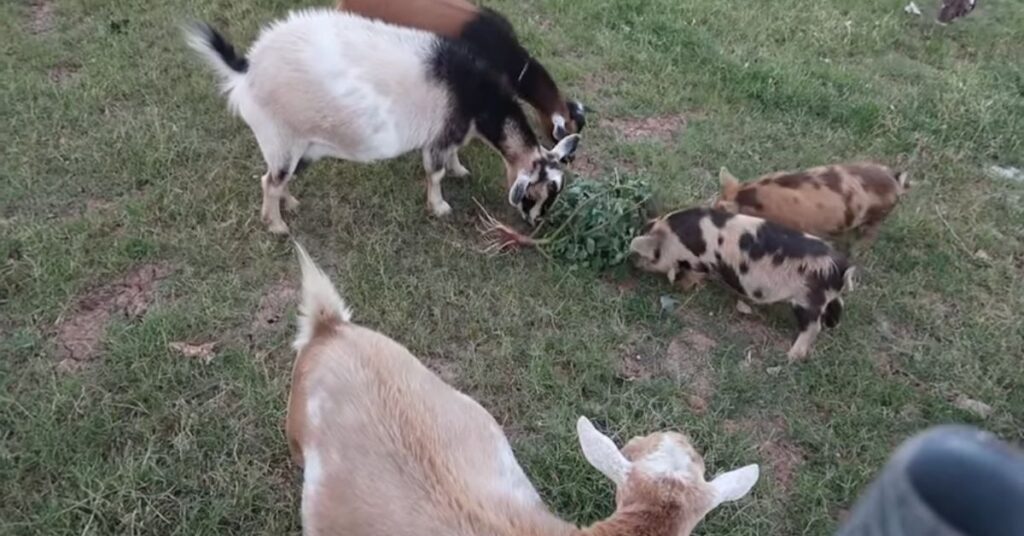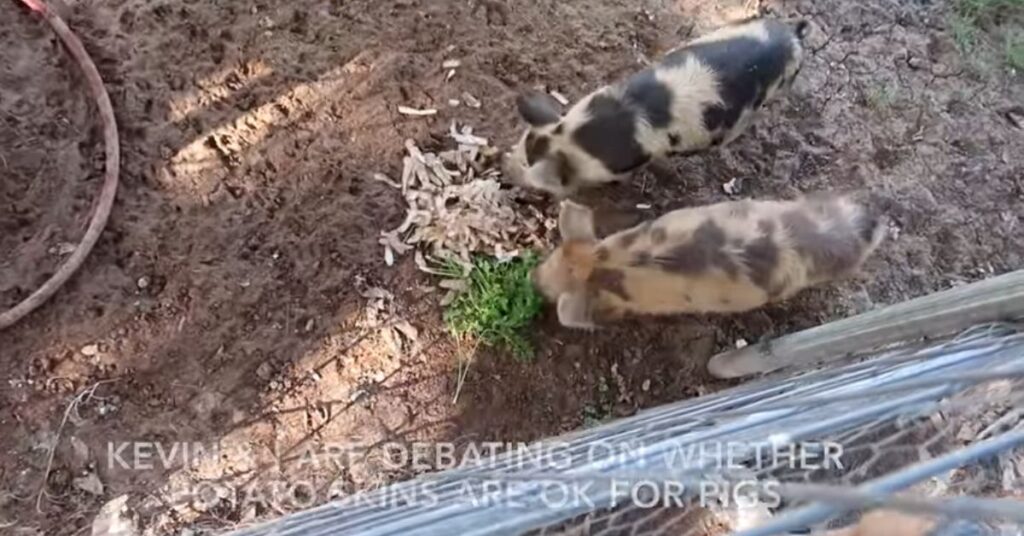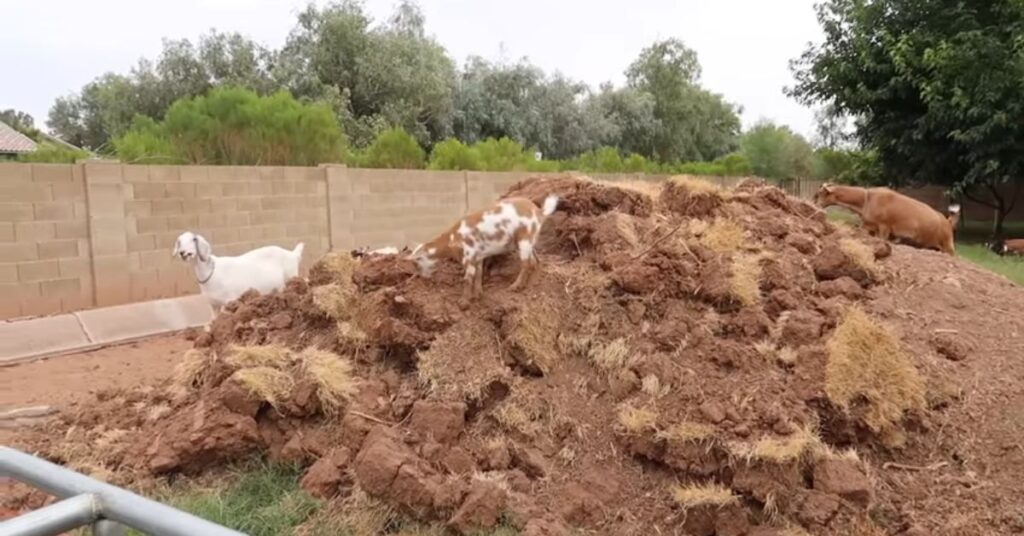Raising goats and pigs together on a small farm or homestead can seem like a convenient and efficient way to produce meat, milk, and manure.
However, goats and pigs have very different needs when it comes to housing, feeding, health management and behavior. While it is possible for goats and pigs to coexist, careful consideration needs to be given to prevent injury, disease transmission and stress.
Here is a comprehensive look at the pros and cons of housing goats and pigs together.
The Nutritional Needs of Goats and Pigs
Goats and pigs have very different nutritional requirements due to their distinct digestive systems and feeding behaviors.
Goats are Ruminants
Goats are ruminants, meaning they have a four-chambered stomach that allows them to digest plants high in cellulose that pigs cannot digest.
Goats should be fed:
- A diet high in coarse, fibrous roughage such as grass, hay, leaves and twigs. They require 2-4 pounds of hay per 100 lbs of body weight per day.
- Grain or concentrated feed in limited quantities (no more than 1 lb per 100 lbs body weight per day). Too much grain can cause metabolic diseases.
- Clean, fresh water at all times.
- Loose minerals formulated specifically for goats to allow free-choice intake.
Pigs are Monogastrics
Pigs only have one stomach chamber and cannot efficiently digest high-fiber feeds.
Pigs require:
- High protein feeds like grain, soybean meal and whey. Pig rations should contain 16-18% protein.
- 5% or less crude fiber in the diet for proper digestion.
- Clean, cool drinking water.
- A trace mineral premix added to feed or given free choice.
If fed together, the pigs will over-consume the goat’s grain ration which can lead to obesity. The goats cannot thrive on the low-fiber pig diet. It is best to house them separately at feeding time or offer species-specific diets in individual stalls.

The Social Structure of Goats and Pigs
Goats and pigs exhibit very different social dynamics and grouping behaviors. Understanding the social nature of each species can help prevent conflict and injuries.
Goats are Gregarious
Goats are social herd animals that roam together and graze in groups. The herd offers protection from predators. Establishing a hierarchy or “pecking order” is very important in a goat herd.
Goats determine dominance by posturing behaviors like staring, vocalizing, and clashing horns. Fighting rarely occurs once the hierarchy is settled. The herd queen rules over the other goats.
New goats introduced to a herd will disrupt the existing social order. The same goes for adding pigs – the goats will act aggressive until dominance is established.
Pigs Prefer Their Own Kind
Pigs are also extremely social but they prefer to be grouped with other pigs over goats or other species.
In larger groups, pigs establish a clear hierarchy and defend resources. Fighting is common with tusk slashes on the shoulders as battle scars.
Pigs view smaller species like goats as prey. They will harass, bite, ram, or even kill goats. The only way to reduce aggression is to raise them together from birth.
For safety, pigs and goats should have separate housing and pastures. Fences need to be strong enough to keep pigs contained.
The Contrasting Behaviors of Goats and Pigs
The different grazing, wallowing, and sleeping behaviors of goats and pigs make them incompatible when housed together.
Goats Are Browsers
Goats prefer to browse on shrubs, trees, vines and weeds over grazing on grass. They stand on their hind legs to reach edible foliage up to 6 feet high. Goats are picky eaters and will ignore plants they find unpleasant.
Pigs Are Rooters and Grazers
Pigs use their snout to aggressively root and dig up pastures. This destroys the vegetation that goats prefer to browse on.
Pigs are grazers happy to eat most grasses and plants close to the ground. They also appreciate acorns and fallen fruits found when rooting.
The pigs disrupt the browsing habitat needed by the goats. Separate pastures are ideal so both species can exhibit natural foraging behaviors.
Goats Need Dry Bedding
Goats prefer dry, elevated surfaces to rest and sleep. They want to stay clean and dry because moisture can cause hoof rot and skin conditions.
Goats climb and jump on platforms in the barn. Outside they rest in shade against trees or structures.
Pigs Require Wallows
Pigs do not sweat and need access to mud wallows to cool off in the heat. They use mud to coat their skin as protection from sunburn and insects.
Muddy pigs will make the goat’s bedding wet and dirty. Goats hate laying in the mud created by pigs. Separate sleeping quarters are a must.

Preventing Injury and Illness
There are many risks to goat health and safety when kept with pigs. Care should be taken to reduce fighting, parasite transmission and spreading contagious diseases between the species.
Aggressive Pigs Can Injure Goats
The risk of physical injury is high when housing pigs and goats together.
Pigs can seriously harm goats using their sharp teeth and snouts. Goats can also be crushed against walls or fences by the larger pigs.
Never leave new mothers and their young kids unsupervised with pigs. The pig’s predatory instincts may lead them to kill the vulnerable babies.
Internal Parasites Can Spread Between Species
Worm larvae can be picked up when goats and pigs share grazing areas. Rotate pastures and use species-specific dewormers to prevent transmission.
Coccidiosis outbreaks are common when animals are crowded. Keep pens clean and dry to reduce infection risk.
Contagious Diseases Require Herd Separation
Several contagious livestock diseases can spread between pigs and goats including:
- Foot and mouth disease
- Rabies
- Ringworm
- Leptospirosis
- Brucellosis
- Salmonella
Isolate any sick animals immediately. Consult your veterinarian about vaccinating your herd based on region. Never add new animals without proper quarantine.
Facilities and Fencing For Goats and Pigs
Providing adequate housing and strong containment is extremely important when raising goats and pigs together. Their facility requirements vary significantly.
Appropriate Space Requirements
Goats need more overall living space per animal compared to pigs. The recommended minimum area per animal is:
- Goats – 15-25 square feet of indoor housing, 50 square feet per goat in outdoor exercise lots.
- Pigs – 8-12 square feet per pig indoors, 16-40 square feet per pig in outdoor pens.
Overcrowding leads to increased disease transmission, injuries from fighting, and poor sanitation. It’s best to separate species into their own paddocks or pens to reduce competition for resources.
Provide enough feeding, watering, and resting spaces so all animals can access without crowding. design pens allow subgroups to get away from each other when needed.

Strong Perimeter Fencing is Essential
Goats are experts at escaping through gaps or climbing over short fencing. Pigs use their muscular snouts to root underneath or push through weak areas in the fence line.
Use strong, reinforced fencing materials with small gaps to contain both species. Goat fencing should be a minimum of 4 feet high and pig fencing at least 5 feet tall.
Bury fencing 12-18 inches underground to prevent digging underneath. Adding an electric wire or two around the perimeter can deter escape attempts.
Check the fence daily and promptly repair any breaches. Use proper corner bracing and line posts every 8-10 feet to strengthen the fence.
Goat Housing Should Allow Climbing
Goats prefer elevated surfaces to rest and sleep. They have an agile climbing ability.
Install sturdy platforms, boxes, or surfaces at least 3 feet high in the barn for goats to jump up on. This keeps them dry.
Add ramps or steps if the animals have difficulty accessing higher areas. Smooth wooden surfaces are ideal.
Pigs are content sleeping on straw bedding they can nest into. They tend to waste hay placed in racks up off the ground.
Keeping separate sleeping quarters reduces mess and helps each species stay cleaner and more comfortable.
Outdoor Housing Considerations
Construct a pig wallow outdoors, situated away from main goat areas. This prevents wet muddy conditions goats dislike.
Provide goats with outdoor platforms, jungle gyms, or large rocks to climb upon and rest on. Offer shady spots to get relief from the sun.
Rotating between paddocks gives the vegetation a chance to regrow after being destroyed by pig rooting behaviors. Separate pastures is ideal for grazing management.
Consider adding simple hutches, shelters or shade structures in each paddock for animals to get out of extreme weather. Face openings away from prevailing winds.

Special Considerations for Managing Goats and Pigs
If you decide to raise goats and pigs together, here are some tips to improve care and prevent issues:
- Closely supervise pigs and goats when first mixed to monitor aggressive behaviors.
- House pregnant goats separately from pigs and keep kids protected until bigger.
- Feed species separately or use individual feeding stalls. Remove uneaten feed promptly.
- Supply additional browse for goats if pigs overgraze the vegetation.
- Check goat udders for injury if housing lactating does with pigs.
- Rotate between paddocks to give the land a break from rooting and allow regrowth.
- Maintain strict biosecurity. Isolate any sick animals and limit visitors and deliveries.
- Schedule regular vet exams for the herd and promptly treat any injuries or illness.
- Consult your veterinarian aboutdeworming, immunizations, and medications for pigs and goats.
- Have species-specific handling equipment like leads and restraints. Never tie goats and pigs together.
- Consider adding a guard animal like a donkey, llama or dog to protect goats from pigs.
The Pros and Cons of Housing Pigs and Goats Together
| Pros | Cons |
|---|---|
| Saves space having single pasture and barn | Injuries likely due to pig aggression |
| Lower fencing construction cost | Disease transmission between species |
| Shared manure has high fertilizer value | Goats’ browsing habitat will be destroyed by pigs |
| Lower feed cost if rations can be combined | Dietcannot be balanced for both species |
| Less cleaning with single shelter | Mud and mess from pig wallowing |
| Reduced isolation stress with herd dynamics | Social stress until dominance hierarchy forms |
Conclusion
In summary, raising goats and pigs together requires careful planning and management. Their differing nutritional, health, and environmental needs make cohabitation challenging.
While possible, the risks to biosecurity, injury and proper care of each species are high. The best approach is to house goats and pigs separately with ample pastureland and species-specific housing for each herd.
Consult your livestock veterinarian to determine if your facilities can appropriately meet the needs of both goats and pigs raised together. Focus on preventing fighting, illness and parasitism through attentive husbandry.
With prudence and proper precautions, some small farms are able to successfully raise these two species together. Ensure you have the time, resources and knowledge to do so without jeopardizing the health and well-being of your animals. Let me know if you have any other questions!
References:
- https://www.aphis.usda.gov/publications/wildlife_damage/fs-disease-risk-sheep-goat.pdf
- https://www.noble.org/regenerative-agriculture/livestock/how-multiple-livestock-species-can-be-used-to-benefit-your-ranch/
- https://www.weforum.org/agenda/2018/09/why-people-are-renting-goats-to-graze-their-lawns
- https://animalscience.tamu.edu/2020/07/06/fencing-considerations-for-goats/
- https://extension.psu.edu/courses/swine/nutrition/forages-for-swine/what-type-of-fence-will-i-need-to-pasture-hogs
- https://www.aces.edu/blog/topics/sheep-goats/dairy-goat-and-sheep-nutrition-and-forages/
- https://ohio4h.org/sites/ohio4h/files/imce/animal_science/Show%20Pig%20Nutrition%20-%20FINAL.pdf
- https://ag.umass.edu/crops-dairy-livestock-equine/fact-sheets/housing-working-facilites-for-goats
- https://extension.psu.edu/raising-small-groups-of-pigs
